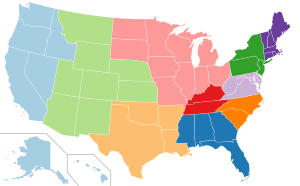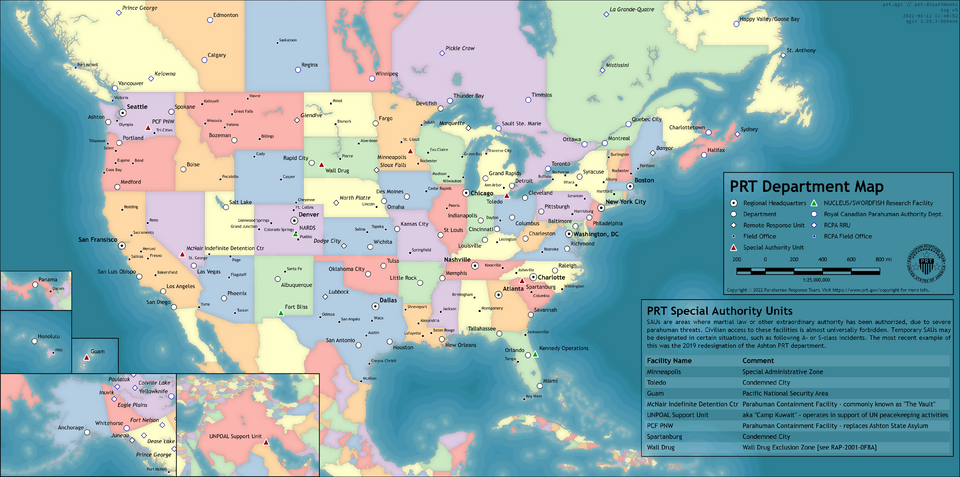Devilfish:Parahuman Response Team
Looking to play the PRT? At the current time, we only allow members with the @PRT tag on the discord to help out as the PRT. If you are interested in this, please contact the Lore Mods and request an application. |
1985, The year that changed the world.
It wasn't long after the appearance of Heimdall that powers began to appear. With the powers came a still-not-understood drive to fight. Heroes and villains alike became less the figments of comic books and shitty cartoons, and more a very real, very present danger.
On March 15, 1985, President Ronald Reagan ordered the creation of the Presidential Parahuman Advisory Committee, with the mission and goal of developing an understanding of the parahuman phenomena. Formed from key officials of the DoD, HHS, DoJ, and State Department, the PPAC was at first regarded as a glorified science experiment, looking for a reason why powers were occurring.
And then the calls started. A national exposé on parahuman crime had aired in primetime, casting a rather negative view on the fledgling society of capes. With the public scared and angry at the potential power the parahumans held, the PPAC was urged to form a unit specializing in tactics to counter capes. This was the birth of the Parahuman Response Team.
Originally a small group flying across the country and educating local SWAT teams, the PRT soon evolved into its own distinct unit under the Department of Justice. Their goal changed as well over the next several years; the early days of "kicking the freaks' skulls in" had turned to "cooperation and oversight of heroes... and kicking the villains' skulls in". Baby steps. By the time the 90s rolled around, the PRT had fully adopted the cape culture as we know it today.
Organization of the PRT
The PRT is headed in Washington, DC, under the rulership of the Chief Director of the PRT, a political appointment that must be confirmed by the senate. As such, most of the day-to-day operations are handled by the Chief Director's direct subordinates, who are each in charge of a different region of the US.
There are PRT departments in every state, ranging from regional headquarters like those in New York, Los Angeles, Denver, Chicago, and Atlanta (among others), to tiny satellite offices in small towns all across America. In each of these cities, the PRT has direct oversight over the local hero teams. In most cases, these are the government-sponsored teams (the Protectorate, and its junior branch, the Wards), however in some cases private and corporate teams may be formally permitted by the PRT in exchange for funding.
Smaller local offices will work alongside local police and emergency services, providing them guidance and support to work with capes, while larger departments will usually staff their own troops. These PRT officers act as a cross between conventional police and military forces, although with a strong bias towards nonlethality.
Day to Day PRT
The duties of the modern PRT are threefold: containing villains, promoting heroes, and finally, overseeing the government-sponsored teams. Each of these duties are headed by a separate organizational unit, some of which are detailed below.
- The Administration segment oversees the entire operations of the three other segments, as well as guidance to the department as a whole.
- The Protectorate segment is comprised entirely of capes and their support staff, and is responsible for all their actions both with day-to-day minutia and long-term strategy for the team. The Wards are a subordinate team to the Protectorate, and use most of the same staff and equipment.
- The Operations segment handles the entire non-parahuman side of PRT law enforcement. PRT officers perform regular patrols, defend key points in the city, and transport prisoners and VIPs as needed. They also collaborate with the Protectorate regularly as needed.
- Finally, the Image department is responsible for publicity for all heroes in the city. Alongside government funding, income from the Image department is responsible for the vast majority of PRT revenue. Thus, their opinion is given heavy weight in all considerations.
Publicity
The Image department's handling of publicity is one of the most important aspects of the PRT. By their very nature, capes are purpose-built to fight and kill, and it is Image's job to convince the public otherwise. To this extent, they have their fingers in a lot of pies:
- The PRT owns and operates outlets in all of their departments, as well as in malls and commercial areas. These outlets sell cape merchandise of all kinds, hero and villain. Profits are distributed to the PRT, PRT teams, and even registered hero teams in the area.
- The issue of villain merchandise can be controversial, however in 1998 this was settled by the Supreme Court in Doe v. PRT, which held that profits from villain merchandise would not be given to the villains in question (other than a portion set aside for them as a prison commissary account). Note that the PRT does not sell merchandise from particularly infamous villains, in these cases the consumer must try another merchant.
- Image will also handle outfitting of costumes for capes. For the independent heroes willing to work with the PRT, this can be a cheap and practical alternative to commissioning one's own work.
- They also handle media arrangements and other, more conventional publicity work for heroes and the PRT.
- Finally, the PRT retains a 20% stake in Parahumans Online, which it founded in 1993. Currently the PRT has no role in the operations of PHO, although the more tinfoil-loving critics will claim otherwise.
Containment Foam
Confoam is the most valuable tool in the PRT's arsenal, however, it is also one of the rarest-used. Manufactured at an undisclosed location somewhere in the Midwest, confoam is a liquid that, when sprayed through a specialized launcher, will quickly form an incredibly-hard (and impossible to escape from) foaming glue.
While all PRT squads train to use confoam (the launcher is large and bulky, requiring two people to operate), it is seldom used due to both cost and liability reasons. It is only deployable on order of the Director or Operations Deputy Director, an action that will only occur for the most wanted of criminals. Even maintaining the equipment costs an alarming amount, so its use is seldom.

